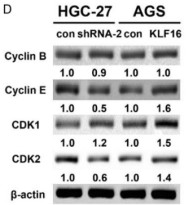ARG62960
anti-CDK1 / CDC2 antibody [POH-1]
anti-CDK1 / CDC2 antibody [POH-1] for ICC/IF,IHC-Formalin-fixed paraffin-embedded sections,Immunoprecipitation,Western blot and Human,Bovine,Primates
Cell Biology and Cellular Response antibody; Gene Regulation antibody; Neuroscience antibody

1
概述
| 产品描述 | Mouse Monoclonal antibody [POH-1] recognizes CDK1 / CDC2 |
|---|---|
| 反应物种 | Hu, Bov, NHuPrm |
| 不反应物种 | Ms, Rat, Dm, Xenopus laevis |
| 应用 | ICC/IF, IHC-P, IP, WB |
| 特异性 | The clone POH-1 specifically detects Cdk1 (p34Cdc2). Staining of Cdk1 reflects the proliferating potential of respective tissue. |
| 宿主 | Mouse |
| 克隆 | Monoclonal |
| 克隆号 | POH-1 |
| 同位型 | IgG2a |
| 靶点名称 | CDK1 / CDC2 |
| 抗原物种 | Human |
| 抗原 | Bacterially expressed full-length human Cdk1 protein |
| 偶联标记 | Un-conjugated |
| 別名 | CDK1; Cyclin Dependent Kinase 1; CDC28A; CDC2; Cell Division Cycle 2, G1 To S And G2 To M; Cell Division Control Protein 2 Homolog; Cell Division Protein Kinase 1; Cyclin-Dependent Kinase 1; P34 Protein Kinase; P34CDC2; Cell Cycle Controller CDC2; EC 2.7.11.22; EC 2.7.11.23; CDKN1 |
应用说明
| 应用建议 |
|
||||||||||
|---|---|---|---|---|---|---|---|---|---|---|---|
| 应用说明 | * The dilutions indicate recommended starting dilutions and the optimal dilutions or concentrations should be determined by the scientist. | ||||||||||
| 阳性对照 | IHC-P: Thymus tissue. |
属性
| 形式 | Liquid |
|---|---|
| 纯化 | Purified from ascites by protein-A affinity chromatography. |
| 纯度 | > 95% (by SDS-PAGE) |
| 缓冲液 | PBS (pH 7.4) and 15 mM Sodium azide |
| 抗菌剂 | 15 mM Sodium azide |
| 浓度 | 1 mg/ml |
| 存放说明 | For continuous use, store undiluted antibody at 2-8°C for up to a week. For long-term storage, aliquot and store at -20°C or below. Storage in frost free freezers is not recommended. Avoid repeated freeze/thaw cycles. Suggest spin the vial prior to opening. The antibody solution should be gently mixed before use. |
| 注意事项 | For laboratory research only, not for drug, diagnostic or other use. |
生物信息
| 数据库连接 | |
|---|---|
| 基因名称 | CDK1 |
| 全名 | cyclin-dependent kinase 1 |
| 背景介绍 | The protein encoded by this gene is a member of the Ser/Thr protein kinase family. This protein is a catalytic subunit of the highly conserved protein kinase complex known as M-phase promoting factor (MPF), which is essential for G2/M phase transitions of eukaryotic cell cycle. Mitotic cyclins stably associate with this protein and function as regulatory subunits. The kinase activity of this protein is controlled by cyclin accumulation and destruction through the cell cycle. The phosphorylation and dephosphorylation of this protein also play important regulatory roles in cell cycle control. Alternatively spliced transcript variants encoding different isoforms have been found for this gene. [provided by RefSeq, May 2023] |
| 生物功能 | Plays a key role in the control of the eukaryotic cell cycle by modulating the centrosome cycle as well as mitotic onset; promotes G2-M transition via association with multiple interphase cyclins. [UniProt] |
| 细胞定位 | Cytoplasm, Cytoskeleton, Mitochondrion, Nucleus. [UniProt] |
| 研究领域 | Cell Biology and Cellular Response antibody; Gene Regulation antibody; Neuroscience antibody |
| 预测分子量 | 34 kDa |
| 翻译后修饰 | Acetylation, Isopeptide bond, Phosphoprotein, Ubl conjugation. [UniProt] |
检测图片 (3) Click the Picture to Zoom In
-
ARG62960 anti-CDK1 / CDC2 antibody [POH-1] WB image
Western blot: HGC-27 stained with ARG55257 anti-Cyclin B1 antibody, ARG58045 anti-Cyclin E1 antibody, ARG62960 anti-CDK1 / CDC2 antibody [POH-1] and ARG57411 anti-CDK2 antibody.
From Sun DP et al. Am J Cancer Res- (2021), PMID: 34249424, Fig. 3. D.
-
ARG62960 anti-CDK1 / CDC2 antibody [POH-1] IHC-P image
Immunohistochemistry: Human thymus (paraffin sections) stained with ARG62960 anti-CDK1 / CDC2 antibody [POH-1].
-
ARG62960 anti-CDK1 / CDC2 antibody [POH-1] WB image
Western blot: 20 µg of Jurkat and HeLa cell lysates stained with ARG62960 anti-CDK1 / CDC2 antibody [POH-1] at 1:1000 dilution.
客户反馈












